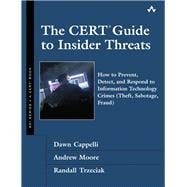
What is included with this book?
Dawn Cappelli, CISSP, is Technical Manager of the CERT Insider Threat Center and the Enterprise Threat and Vulnerability Management Team at Carnegie Mellon University’s Software Engineering Institute (SEI). She has spent the past decade working with organizations such as the U.S. Secret Service and Department of Homeland Security in protecting the United States against insider threats. Andrew Moore is Lead Researcher in the CERT Insider Threat Center and Senior Member of Technical Staff at SEI. Randall Trzeciak is a Senior Member of Technical Staff at SEI, and Technical Team Lead for the Insider Threat Research Group at the CERT Insider Threat Center.
Preface xvii
Acknowledgments xxxi
Chapter 1: Overview 1
True Stories of Insider Attacks 3
The Expanding Complexity of Insider Threats 6
Breakdown of Cases in the Insider Threat Database 7
CERT’s MERIT Models of Insider Threats 9
Overview of the CERT Insider Threat Center 13
Timeline of the CERT Program’s Insider Threat Work. 16
Caveats about Our Work 20
Summary 20
Chapter 2: Insider IT Sabotage 23
General Patterns in Insider IT Sabotage Crimes 28
Mitigation Strategies 46
Summary 59
Chapter 3: Insider Theft of Intellectual Property 61
Impacts 66
General Patterns in Insider Theft of Intellectual Property Crimes 68
The Entitled Independent 69
The Ambitious Leader 78
Theft of IP inside the United States Involving Foreign Governments or Organizations 83
Mitigation Strategies for All Theft of Intellectual Property Cases 88
Mitigation Strategies: Final Thoughts 97
Summary 98
Chapter 4: Insider Fraud 101
General Patterns in Insider Fraud Crimes 106
Insider Fraud Involving Organized Crime 115
Organizational Issues of Concern and Potential Countermeasures 120
Mitigation Strategies: Final Thoughts 126
Summary 127
Chapter 5: Insider Threat Issues in the Software Development Life Cycle 129
Requirements and System Design Oversights 131
System Implementation, Deployment, and Maintenance Issues 136
Programming Techniques Used As an Insider Attack Tool 139
Mitigation Strategies 142
Summary 143
Chapter 6: Best Practices for the Prevention and Detection of Insider Threats 145
Summary of Practices 146
Practice 1: Consider Threats from Insiders and Business Partners in Enterprise-Wide Risk Assessments 151
Practice 2: Clearly Document and Consistently Enforce Policies and Controls 155
Practice 3: Institute Periodic Security Awareness Training for All Employees 159
Practice 4: Monitor and Respond to Suspicious or Disruptive Behavior, Beginning with the Hiring Process 164
Practice 5: Anticipate and Manage Negative Workplace Issues 168
Practice 6: Track and Secure the Physical Environment 171
Practice 7: Implement Strict Password- and Account-Management Policies and Practices 174
Practice 8: Enforce Separation of Duties and Least Privilege 178
Practice 9: Consider Insider Threats in the Software Development Life Cycle 182
Practice 10: Use Extra Caution with System Administrators and Technical or Privileged Users 187
Practice 11: Implement System Change Controls 191
Practice 12: Log, Monitor, and Audit Employee Online Actions 195
Practice 13: Use Layered Defense against Remote Attacks 200
Practice 14: Deactivate Computer Access Following Termination 203
Practice 15: Implement Secure Backup and Recovery Processes 207
Practice 16: Develop an Insider Incident Response Plan 211
Summary 213
References/Sources of Best Practices 214
Chapter 7: Technical Insider Threat Controls 215
Infrastructure of the Lab 217
Demonstrational Videos 218
High-Priority Mitigation Strategies 219
Control 1: Use of Snort to Detect Exfiltration of Credentials Using IRC 220
Control 2: Use of SiLK to Detect Exfiltration of Data Using VPN 221
Control 3: Use of a SIEM Signature to Detect Potential Precursors to Insider IT Sabotage 223
Control 4: Use of Centralized Logging to Detect Data Exfiltration during an Insider’s Last Days of Employment 231
Insider Threat Exercises 239
Summary 239
Chapter 8: Case Examples 241
Sabotage Cases 241
Sabotage/Fraud Cases 256
Theft of IP Cases 258
Fraud Cases 262
Miscellaneous Cases 269
Summary 273
Chapter 9: Conclusion and Miscellaneous Issues 275
Insider Threat from Trusted Business Partners 275
Malicious Insiders with Ties to the Internet Underground 286
Final Summary 293
Appendix A: Insider Threat Center Products and Services 299
Appendix B: Deeper Dive into the Data 307
Appendix C: CyberSecurity Watch Survey 319
Appendix D: Insider Threat Database Structure 325
Appendix E: Insider Threat Training Simulation: MERIT InterActive 333
Appendix F: System Dynamics Background 345
Glossary of Terms 351
References 359
About the Authors 365
Index 369
The New copy of this book will include any supplemental materials advertised. Please check the title of the book to determine if it should include any access cards, study guides, lab manuals, CDs, etc.
The Used, Rental and eBook copies of this book are not guaranteed to include any supplemental materials. Typically, only the book itself is included. This is true even if the title states it includes any access cards, study guides, lab manuals, CDs, etc.